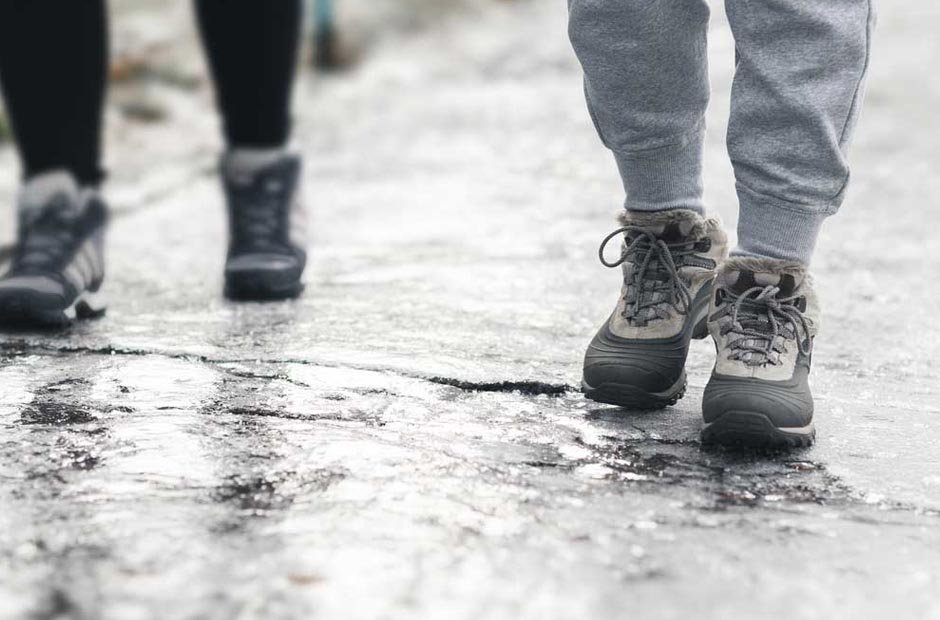As your municipality clears snow following a snowstorm, what’s left underneath all the slippery sidewalks that seemingly little can be done about? While there are many ways to handle slippery sidewalks, they vary in effectiveness.
As it turns out, a little snow, freezing rain, and subfreezing temperatures make for a difficult combination to manage. Still, these slippery sidewalk solutions are all things to tackle those treacherous parts of the sidewalk that threaten anyone’s safety.
Rock Salt
Rock salt lowers precipitation’s freezing point on the ground, melting ice and reducing what could accumulate afterward. Though rock salt is typical and works, it can also cause concrete to rust, crack, and deteriorate, and it harms lawns, gardens, and the environment, finding its way into lakes, streams, and groundwater.
Liquid Deicer
A liquid deicer is a safe product to handle a slippery sidewalk. It is safe for humans and the environment and does not sacrifice quality in performance. Liquid deicer is liquid ice melt.
As it dries, it is a liquid brine that leaves behind a dry salt that reacts with snow and ice to prevent it from bonding to sidewalks and other surfaces. This makes it easy to clear and fast to get done.
What Liquid Deicer to Buy
Look for a liquid deicer or ice melt product for your concrete. Ideally, you want it salt-free, chloride-free, and acetate-free. Many liquid deicers have chlorine or salt in the product, which is alright as long as they are made from natural ingredients and do not contain corrosives. The best liquid deicers are fairly gentle on the concrete, can work at cold temperatures, and are very effective.
Pre-Treat Your Sidewalk
Before your sidewalk gets slippery, don’t wait to act. Pre-treat your concrete by laying down an abrasive or adding some driveway ice melt. This should prevent snow and ice from sticking to the surface and minimize the amount of ice accumulating.
Pre-treating your sidewalk and driveway is a good habit and will reduce the work you must put in later.
Seal Your Concrete
Water will seep through cracks and crevices in the concrete as it snows and rains. When that freezes, so much damage can happen. The water will freeze and refreeze, exerting more pressure on the concrete and the top surface.
In time, this process will push those gaps open and widen. A sealant can cover the cracks and prevent moisture from getting in. This is a smart move to make for any homeowner.
Try Sugar Beet Juice
One of the few all-natural products that can be used on a slippery sidewalk, if you can get around the colour, is sugar beet juice. Juice from sugar beets lowers the melting point of ice. It’s safe for animals, plants, and concrete.
Unlike other natural solutions to slippery sidewalks, sugar beet juice also works in frigid temperatures and won’t freeze over.
Use an Abrasive
Sand is often recommended for use as an abrasive on slippery sidewalks. It grits into the surface and provides traction on which you can walk. That said, sand is not going to help melt anything.
More abrasive options include sawdust, coffee grinds if you don’t mind the smell of coffee across your sidewalk, or kitty litter, which can make a large mess.
Snow Melting Mats
A snow-melting mat plugs into any electrical outlet and will get the job done quickly by clearing ice off a slippery sidewalk. These mats are made with heating elements nestled between two layers of heat-resistant rubber.
This avoids the use of chemicals and is easy to lay down. It does, however, rely on you having an electrical outlet nearby and the time to wait for the mat to do its work. They take 1-2 hours to work.
Use a Hard Shovel
Use a hard shovel if you have nothing else at your disposal. Remove the snow manually. Next, chop the ice until it breaks into pieces and remove it bit by bit from the sidewalk.
To do this, of course, you’ll need a very hard shovel. A lot of effort aside, this can often do the trick for a slippery sidewalk, especially if you’ve got the sun out and beating down already, melting some ice.
Boiling Water
Boiling water is generally a bad idea. It will cool and freeze over like any other water. However, when combined with a hard shovel, it may be the right shock over ice to allow you a short window to break up what’s there and get it gone.
Try boiling water if you need assistance shovelling a slippery sidewalk and exposing the bare concrete underneath the ice.


